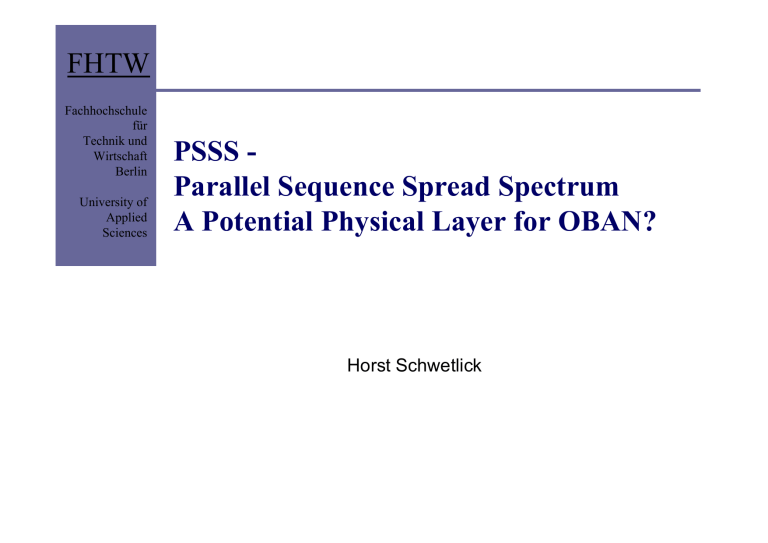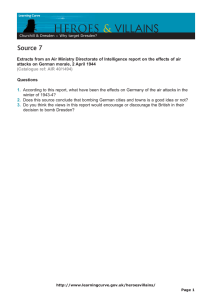PSSS for OBAN: Parallel Sequence Spread Spectrum Presentation
advertisement

FHTW
Fachhochschule
für
Technik und
Wirtschaft
Berlin
University of
Applied
Sciences
PSSS Parallel Sequence Spread Spectrum
A Potential Physical Layer for OBAN?
Horst Schwetlick
Content
PSSS for OBAN ?
Aspects of OBAN - Requirements
Principle of PSSS - Transmission
Performance – Investigations
Potential for OBAN
Conclusion
2
Schwetlick PSSS – Physical Layer for OBAN – OBAN Workshop at the 14th IST Dresden
FHTW-Berlin
OBAN
Requirements
Problems in Wave Propagation
OBAN faces the well known problems of wave propagation and
interference, which can be seen in every wireless application
Technically this refers to the following aspects:
1. Link Budget – Starting with a certain transmission power it
describes all contributions of attenuation during the path of travel
until arriving at the receiver and hence the resulting signal to noise
ratio at the receiver side
2. Multipath Propagation – Due to reflection, diffraction and refraction
the paths from transmitter to receiver do not travel on only one
straight line, rather than of a multiple of propagation paths
3. Co- and adjacent channel interference - Since the ISM bands are
to be used freely, the received signal might be disturbed from
transmitters on same channel or on an arbitrary near neighboring
frequencies
3
Schwetlick PSSS – Physical Layer for OBAN – OBAN Workshop at the 14th IST Dresden
FHTW-Berlin
Frequency Dependence for Freespace
Propagation – Essential for the Link Budget
OBAN
Requirements
Loss in Freespace
m
-130.0
-120.0
-110.0
-100.0
380
-90.0
900
dB
1900
2500
3500
-80.0
5200
-70.0
-60.0
-50.0
-40.0
10
100
1000
10000
(Picture Huber & Suner)
4
Schwetlick PSSS – Physical Layer for OBAN – OBAN Workshop at the 14th IST Dresden
FHTW-Berlin
OBAN
Requirements
Frequency Dependence of Material
Attenuation
Material:
at 2,4 GHz
at 5 GHz
Brick 11,5 cm
Brick 36 cm
Light Concrete 11,5 cm
Light Concrete 30 cm
Limestone 11,5 cm
Reinforced Concrete 16 cm
- 7 dB
- 26 dB
- 12 dB
- 26 dB
- 22 dB
- 20 dB
- 10 dB
- 50 dB
- 19 dB
- 35 dB
- 36 dB
- 32 dB
Increased attenuation by walls at higher frequencies,
Hence, in some cases lower frequencies might have
advantages like the 900 MHZ range
5
Schwetlick PSSS – Physical Layer for OBAN – OBAN Workshop at the 14th IST Dresden
FHTW-Berlin
OBAN
Requirements
Multipath Propagation and Delay Spread
The combination of
indoor- and outdoor environment
LOS and NLOS Propagation
places difficult conditions on the physical layer
Special design of the Physical Layer might reduce these
effects
Spreading
OFDM
(NLOS - Non Line of Sight, LOS - Line of Sight)
6
Schwetlick PSSS – Physical Layer for OBAN – OBAN Workshop at the 14th IST Dresden
FHTW-Berlin
Simulation at 2.4 GHz
Room
Building Walls
Transmitter
Position
Simulation by REMCOM
At FHTW-Berlin
7
Schwetlick PSSS – Physical Layer for OBAN – OBAN Workshop at the 14th IST Dresden
FHTW-Berlin
OBAN
Requirements
Co- and Adjacent Channel Interference
The ISM-Bands are not restricted within certain limits
So interference can be induced by networks,
working at neighboring frequencies
and
working at the same frequency
Mitigation the effects by
Directing antennas
Processing of baseband signals
Using other, less heavy used frequencies
8
Schwetlick PSSS – Physical Layer for OBAN – OBAN Workshop at the 14th IST Dresden
FHTW-Berlin
OBAN
Requirements
Discussion
Can OBAN work with other systems than 802.11x in the 2.4
GHz Band?
The future might bring other systems to WLANs for
serving of facilities in households and offices,
eg. systems at the 802.15 xx might leave free capacities
Different interfaces at the host PC, working simultaneously
with different systems and at different frequency ranges
could serve the availability of network access depending on
the presence of wireless networks in the certain environment
Spacial-, System- and Frequency-Roaming
One of these additional systems might be PSSS?
9
Schwetlick PSSS – Physical Layer for OBAN – OBAN Workshop at the 14th IST Dresden
FHTW-Berlin
PSSSPrinciple
Parallel Sequence Spread Spectrum
PSSS uses the CDMA-principle and sends in parallel a
superposition of orthogonal sequences with M-ary
modulation
It combines code multiplex of cyclically shifted Msequences with block transfer of short data segments
This approach combines scalable the advantages of
spreading with the transmission of higher data rates
10
Schwetlick PSSS – Physical Layer for OBAN – OBAN Workshop at the 14th IST Dresden
FHTW-Berlin
PSSSPrinciple
Basic Principle
Special correlation properties of M-sequences are
utilised:
Cyclic Correlation of a bipolar version with an unipolar
version of the same M-sequence yields a discrete delta
impulse
Bipolar
Sequence
Resulting Delta
Impulse
Unipolar
Sequence
11
Schwetlick PSSS – Physical Layer for OBAN – OBAN Workshop at the 14th IST Dresden
FHTW-Berlin
PSSSPrinciple
Basic Principle
Hence
one data bit is spreaded by the M-sequence
Send through the transmission channel
Received
Despreaded to a single pulse using cyclic correlation
Cyclic shifted impulses are orthogonal and can be
superpositioned to a multivalent sequence
No sidelobes due to the cyclic correllation appear
- Therefore no increase of intersymbol interference
12
Schwetlick PSSS – Physical Layer for OBAN – OBAN Workshop at the 14th IST Dresden
FHTW-Berlin
PSSSPrinciple
Cyclic Correlation
M-sequence of length L
A = {a1 a2 ... ai ... aL
Unipolar representation
B = {b1 b2 ... bi ... bL
Cyclical correlation
}
}
L
C = A ⊗B
∑ a b(
i =1
Results in a delta impuls
13
⎧ +1
ak = ⎨
⎩ -1
ak + 1 ⎧1
=⎨
bk =
2
⎩0
i
i + k ) mod L
= ck
⎧ L +1
for k =0
⎪
ck = ⎨ 2
⎪⎩ 0 else
Schwetlick PSSS – Physical Layer for OBAN – OBAN Workshop at the 14th IST Dresden
FHTW-Berlin
PSSSPrinciple
Cyclic Correlation
If the sequence
Bi = {bi ,1,bi ,2, ... bi ,k
is cyclically shifted
by a displacement i
⎧+1
A = {a1, a2, ... ak ... aL } , ak = ⎨
⎩−1
Ci = A ⊗ Bi
then, after the correlation
the resulting delta impulse
is also shifted by the same
displacement
14
a( k +i ) mod L + 1 ⎧1
=⎨
... bi , L } , bi ,k =
2
⎩0
⎧ L +1
for k = i
⎪
Ci = ⎨ 2
⎪⎩ 0
else
Schwetlick PSSS – Physical Layer for OBAN – OBAN Workshop at the 14th IST Dresden
FHTW-Berlin
PSSSPrinciple
Cyclic Correlation
Orthogonality of the shifted sequences Bi is maintained
when sequences Bi are multiplied by a data word, i.e.
+1 or -1
and by superposition of sequences
The presence or polarity of a certain sequences in
number of superpositioned sequences is detected by the
cyclic correlation and threshholding a delta function
Hence, the presence or polarity of a certain sequence can
represent one bit of information
15
Schwetlick PSSS – Physical Layer for OBAN – OBAN Workshop at the 14th IST Dresden
FHTW-Berlin
PSSSPrinciple
Superposition of the Shifted Sequences
The payload information is represented by the data sequence
D of length K
D = {d1 d 2 ... d i ... d K
}
⎧ +1 for a 1-Bit
di = ⎨
, 0 ≤ i ≤ K -1
⎩ −1 for a 0-Bit
Bi = {bi ,1,bi ,2, ... bi ,k ... bi , L } , bi ,k =
a( k +i ) mod L + 1
Ci = Bi di
2
⎧1
=⎨
⎩0
L
∑C
i =1
i
=X
The sequence to be transmitted X is multivalent and of length L
16
Schwetlick PSSS – Physical Layer for OBAN – OBAN Workshop at the 14th IST Dresden
FHTW-Berlin
PSSSPrinciple
PSSS-Sequence
The code sequence X (referred to as PSSS-sequence) is
the base band signal of the PSSS-procedure
After modulation, RF-transmission, reception and
demodulation the sequence X’ is received
The cyclical correlation of the multivalent sequence X’
leads to a sequence of soft bits D’
The data sequence is reconstructed by threshholding
these soft bits
17
Schwetlick PSSS – Physical Layer for OBAN – OBAN Workshop at the 14th IST Dresden
FHTW-Berlin
Transmission of a PSSS-Sequence
d1
B1
d2
Multivalued
Code Sequence C
B2
dj
Selection
Cyclic
Correlation
C with A
Σ
of
dk
Transmitter
Bk
Receiver
Summarization of the process of spreading, superposition and correlation
18
Schwetlick PSSS – Physical Layer for OBAN – OBAN Workshop at the 14th IST Dresden
d2
dj
Data Bits
Bj
d1
FHTW-Berlin
dk
PSSSPrinciple
The PSSS Data Stream
Channel
Impulse
Response
Cyclic Correlation
PSSS-Signal
Guard Interval
19
Schwetlick PSSS – Physical Layer for OBAN – OBAN Workshop at the 14th IST Dresden
FHTW-Berlin
PSSSPrinciple
Transmission of a PSSS-Sequence
d1
B1
d2
Multivalued
Code Sequence C
B2
dj
Σ
Guard Interval
Appended
Bj
Selection
Cyclic
Correlation
C with A
of
Transmitter
Data Bits
Receiver
Summarization of the process of spreading, superposition and correlation
20
Schwetlick PSSS – Physical Layer for OBAN – OBAN Workshop at the 14th IST Dresden
d2
dj
dk
Bk
d1
FHTW-Berlin
dk
PSSSPrinciple
Generatiom of the Sequences at the
Transmitter Side
d1
Multivalued
Code Sequence C
B1
d2
Selection
B2
Cyclic
Correlation
C with A
Σ
dk
Bk
Transmitter Receiver
d1
d2
of
dj
Data Bits
dk
Assume that one block of PSSS-data includes K data bits
Each of these K data bits is multiplied with one cyclically
shifted spreading sequence
21
Schwetlick PSSS – Physical Layer for OBAN – OBAN Workshop at the 14th IST Dresden
FHTW-Berlin
PSSSPrinciple
Superposition of Spreading Sequences
at the Transmitter Side
d1
Multivalued
Code Sequence C
B1
d2
Selection
B2
Cyclic
Correlation
C with A
Σ
dk
Bk
Transmitter Receiver
d1
d2
of
dj
Data Bits
dk
All K sequences are added and form one PSSSsequence
The resulting multivalent sequence is modulated and
transmitted
22
Schwetlick PSSS – Physical Layer for OBAN – OBAN Workshop at the 14th IST Dresden
FHTW-Berlin
PSSSPrinciple
Appending a Guard Interval
d1
Guard Interval
Appended
B1
d2
Selection
B2
Cyclic
Correlation
C with A
Σ
dk
Bk
Transmitter Receiver
d1
d2
of
dj
Data Bits
dk
A guard interval is appended to avoid interference
between subsequent PSSS-Blocks
23
Schwetlick PSSS – Physical Layer for OBAN – OBAN Workshop at the 14th IST Dresden
FHTW-Berlin
PSSSPrinciple
Reconstruction at the Receiver Side
d1
B1
Transmitted Sequence
d2
Selection
B2
Cyclic
Correlation
C with A
Σ
dk
Bk
Transmitter Receiver
d1
d2
of
dj
Data Bits
dk
The PSSS-sequence is reproduced by the demodulation
The cyclic correlation of the received sequence with the
original spreading sequence yields the original data bits
24
Schwetlick PSSS – Physical Layer for OBAN – OBAN Workshop at the 14th IST Dresden
FHTW-Berlin
PSSSPrinciple
Reassembling Data Bits at the
Receiver Side
d1
B1
Transmitted Sequence
d2
Selection
B2
Cyclic
Correlation
C with A
Σ
dk
Bk
Transmitter Receiver
d1
d2
of
dj
Data Bits
dk
These data bits are reassembled to the original data
stream
25
Schwetlick PSSS – Physical Layer for OBAN – OBAN Workshop at the 14th IST Dresden
FHTW-Berlin
PSSSPrinciple
PSSS – Overlap of 31 Sequences and
Reconstruction
The Example with of K = L bits shows the spreading sequence of
length 31, the original data sequence, the multivalent PSSSsequence and the reconstructed sequence
26
Schwetlick PSSS – Physical Layer for OBAN – OBAN Workshop at the 14th IST Dresden
FHTW-Berlin
PSSSPrinciple
Comparison: OFDM versus PSSS
Guard Interval
Data
Code
Guard
Data
Time
Frequency
Frequency
OFDM
27
PSSS
Schwetlick PSSS – Physical Layer for OBAN – OBAN Workshop at the 14th IST Dresden
FHTW-Berlin
PSSSPrinciple
Increasing Multipath Fading
Resistance by Scaling PSSS
With the multivalent sequence X of length L a maximum
number of K bits can be transmitted → L = K
For a scaled usage, not all L shifted sequences must be
used
Since the gaps between the reconstructed delta
functions get larger, this increases the resistance to
multipath fading
Hence, a tradeoff between interference resistance and
data rate is achieved
28
Schwetlick PSSS – Physical Layer for OBAN – OBAN Workshop at the 14th IST Dresden
FHTW-Berlin
Modulation
Amplitude Distribution of PSSSSequences
Every element of the PSSS-sequence forms a
multivalent chip, which is transmitted with one
modulation symbol
It is noticed that the amplitude distribution of the PSSSsequence is data-dependent and not uniformly
distributed → approximately a Gauss distribution
The maximum of the amplitude distribution is at
zero
small values appear more often as higher values
29
Schwetlick PSSS – Physical Layer for OBAN – OBAN Workshop at the 14th IST Dresden
FHTW-Berlin
PSSSPrinciple
30
Non-Uniform Amplitude Distribution
of the PSSS - Baseband Signal
Schwetlick PSSS – Physical Layer for OBAN – OBAN Workshop at the 14th IST Dresden
FHTW-Berlin
Performance
MODULATION
Different Modulation Methods can transmit the PSSS
sequence X, e.g.:
M-PAM
M-QAM
M-QPSK
31
Schwetlick PSSS – Physical Layer for OBAN – OBAN Workshop at the 14th IST Dresden
FHTW-Berlin
Performance
PSSS with M-PAM
The simplest modulation method is given with M-PAM.
The PSSS-signal is transmitted by a double side band
modulation
Transfer rates up to 1 bit/symbol are obtained by this
procedure
If not all possible sequences are overlapped, lower data
rates are possible with a corresponding spreading gain
32
Schwetlick PSSS – Physical Layer for OBAN – OBAN Workshop at the 14th IST Dresden
FHTW-Berlin
Performance
33
PSSS with M-PAM
Schwetlick PSSS – Physical Layer for OBAN – OBAN Workshop at the 14th IST Dresden
FHTW-Berlin
Performance
34
PSSS with M-PAM
Schwetlick PSSS – Physical Layer for OBAN – OBAN Workshop at the 14th IST Dresden
FHTW-Berlin
Performance
PSSS with M-QAM
An increased data rate can be achieved with M-QAM
In this case two PSSS-Sequences as I- and Q-Signal are
fed to the modulator
The corresponding curves for M-QAM are plotted for
comparison in the diagram
M was chosen 17*17=289, were the higher amplitude
values are rare or do not appear
35
Schwetlick PSSS – Physical Layer for OBAN – OBAN Workshop at the 14th IST Dresden
FHTW-Berlin
Performance
36
Constellation diagram and BER(EbN0)
with M-QAM
Schwetlick PSSS – Physical Layer for OBAN – OBAN Workshop at the 14th IST Dresden
FHTW-Berlin
Performance
PSSS with M-PSK
M-PSK as a modulation method has the advantage,
sending with a largely constant power since the PSSSsequence controls the phase angle
Due to the amplitude distribution a 16-PSK was used
Bit error performance is slightly less than with QAM
37
Schwetlick PSSS – Physical Layer for OBAN – OBAN Workshop at the 14th IST Dresden
FHTW-Berlin
Performance
38
Constellation diagram and BER(EbN0)
with M-PSK
Schwetlick PSSS – Physical Layer for OBAN – OBAN Workshop at the 14th IST Dresden
FHTW-Berlin
Performance
PSSS-Transceiver Hardware
MAXIM Eval-Board
Here as transmitter
32 - QAM
DAC - Board
39
Schwetlick PSSS – Physical Layer for OBAN – OBAN Workshop at the 14th IST Dresden
CESYS - Spartan2
FPGA (Virtex)
FHTW-Berlin
Performance
PSSS – Performance and Results
In the current version of investigation data rates from 2
bit/s/Hz scalable down to lower rates with the
advantages of signal spreading
Bit Error Rate is comparable to unipolar BPSK
Advantageous bit error structure → favorably compatible
with an outer channel coding
Implementation advantages – simpler hardware
Rake Receiver is not necessary
Hence low electricity consumption
40
Schwetlick PSSS – Physical Layer for OBAN – OBAN Workshop at the 14th IST Dresden
FHTW-Berlin
Conclusion
Application Areas of PSSS
General Radio Link
Cable Substitute for General Applications
Areas with Multipath Fading
WLAN / WPAN
Wireless industrial control
Home automatisation and control
Audio-/ video-/ general data transmission in home
applications
41
Schwetlick PSSS – Physical Layer for OBAN – OBAN Workshop at the 14th IST Dresden
FHTW-Berlin
Conclusion
42
Integration of PSSS into IEEE 802.15.4.b
PSSS is in the ongoing discussion for IEEE 802.15.4.b
Potential Physical Layer for ZigBee
Data Rate of 250 kbit/s
Frequency Range: Low Band 868 MHz and 915 MHz
M-Sequence of Length 31 ( 25-1 )
At 20 Superpositioned Sequences
Schwetlick PSSS – Physical Layer for OBAN – OBAN Workshop at the 14th IST Dresden
FHTW-Berlin
Conclusion
Future Potential
Subjects of application and further investigations are
Integration of channel equalization
Integration of MIMO
Point to multi-point connections with different channels
Pre-Coding using the amplitude statistics
Dynamic assignment of transfer capacities to adapt to
different channel requirements including
data rate
multipath fading and
delay spread
43
Schwetlick PSSS – Physical Layer for OBAN – OBAN Workshop at the 14th IST Dresden
FHTW-Berlin
Conclusion
Conclusion
When an increasing number of networks, also other than
WLAN in the 2.4 GHz Range become present, additional
capacities might become available
These networks might not be heavily used all time
With a proper priorisation between internal and guest
usage these capacities could be made available
PSSS might become one of this technlogies, particular if
extended to higher data rates
These capacities might serve OBAN as well
44
Schwetlick PSSS – Physical Layer for OBAN – OBAN Workshop at the 14th IST Dresden
FHTW-Berlin
FHTW
Fachhochschule
für
Technik und
Wirtschaft
Berlin
University of
Applied
Sciences
Thank You
This work was partly sponsored by the BMBF AIF FH3 Program
References
A. Kuzminskiy, H.R. Karimi, E. Edvardsen, J. C. Francis,
Interference Scenarios in Future Wireless Open Access
Networks, WWRF 11th Meeting, Oslo-Norway (2004)
A. Wolf, German Patentschrift zu PSSS (2003)
H. Schwetlick, A. Wolf: PSSS (Parallel Sequence Spread
Spectrum) Application in RF-Communication, 8th IEEE
International Symposium on Consumer Electronics,
Reading, UK (2004)
46
Schwetlick PSSS – Physical Layer for OBAN – OBAN Workshop at the 14th IST Dresden
FHTW-Berlin




